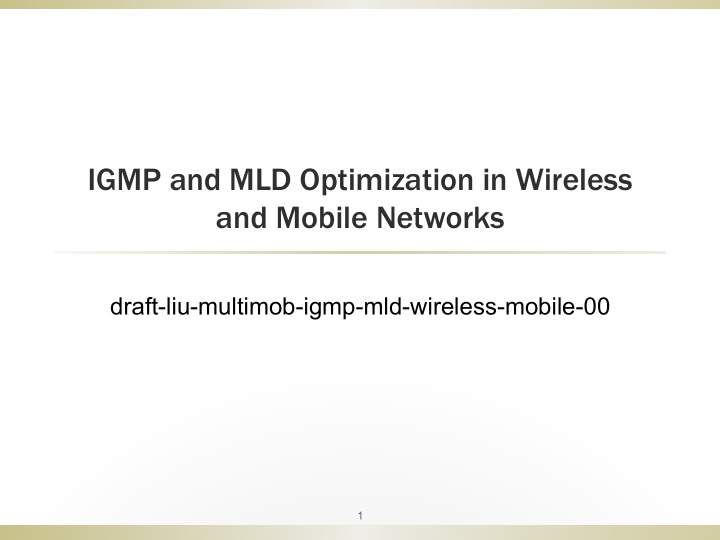



IGMP and MLD Optimization in Wireless and Mobile Networks draft-liu-multimob-igmp-mld-wireless-mobile-00 1
Aims ß Optimize IGMP and MLD to meet wireless or mobile multicast network requirements: ß Adaptive to link conditions ß Minimal group Join/Leave latency ß Robust to packet loss ß Reducing packet exchange ß Avoiding packet burst ß Limit the changes within the protocol framework without introducing interoperability issues ß Possibly used in wired network where efficiency and robustness are required 2
Option List ß Switching between unicast and multicast Queries ß General Query supplemented with unicast Query ß Retransmission of General Query ß General Query suppression with no receiver ß Tuning Response Delay according to link type ß Triggering Report and Query quickly during handover 3
Switching Between Unicast and Multicast General Queries ß Add the capability of a router to query just 1 receiver by setting the destination as unicast address ß Enable the router to switch between unicast and multicast Queries according to actual network conditions ß Use unicast Query to each receiver when number of valid receivers is small, while using multicast Query as normal when receiver number is large ß A threshold is predefined to enable the switching ß Explicit tracking is required to know the link state ß Benefits ß Take advantages of both unicast and multicast Query ß Unicast Query has less effect on non-members and helps improve batter-saving 4
General Query Supplemented with Unicast General Query ß Send unicast Query to non-respondent valid receivers after a run of normal General Query, presumably the scale of non-respondent receiver is small ß Reasons of non-responding valid receivers ß Receiver silently leaves the network without notification ß Reports are lost due to unstable link condition and etc. ß Trigger unicast Query at the end of the [Maximum Response Delay], and retransmit for [Last Member Query Count] times ß Require explicit tracking to be enabled ß Benefit ß Improve Robustness without influencing other normal receivers 5
General Query Suppression with no Receiver ß Suppress General Query if there is no valid multicast receiver on an interface ß Example Scenarios ß When last member reports its leave, by an explicit tracking router checking its membership database, or by a non-explicit-tracking router getting no response after sending Group-(and-Source-) Specific Queries ß When the (only) member on a PTP link reports its leave ß When a router after retransmitting General Queries on startup fails to get any response ß When a router previously has valid members but fails to get any response after several rounds of General Queries. ß Benefit ß Eliminate unnecessary continuous General Query have benefits for all terminal on the link for battery saving 6
Retransmission of General Query ß If after a General Query no response can be collected from all valid receivers, for one of the reasons of: ß All valid receivers leave the group silently or moved out of range ß All the responses of the receivers happen to be lost ß Query does not arrive at the other side of the link to the receivers. ß Retransmit General Queries for [Last Member Query Count] times before deciding to stop General Query finally ß Require explicit tracking to be enabled ß Benefit ß Improve robustness of General Query if there are valid members ß Realize fast leave if all the receivers quit. 7
Tuning Response Delay according to link type and status ß Tuning maximum response delay according to link type and status to reduce message burst and leave latency, according to the expected number of responders, and link type and status: ß If the expected number of reporters is large and/or link condition is bad, select larger [Maximum Response Delay] ß If the expected number of reporters is small and/or the link condition is good, select smaller Delay ß If link mode is PTP, choose smaller Delay; if link mode is PTMP or broadcast, configure larger Delay . 8
Triggering Reports and Queries during handover ß Access router triggers a Query (General Query or unicast General Query) as it detects a new terminal on its link. ß Terminal triggers a Report as soon as it detects connection to new network, if it is just in multicast reception state ß Benefits ß During handover, new access network acquire terminal’s membership and deliver the content to the receiver quickly to help reducing disruption or performance deterioration. . 9
Recommend
More recommend